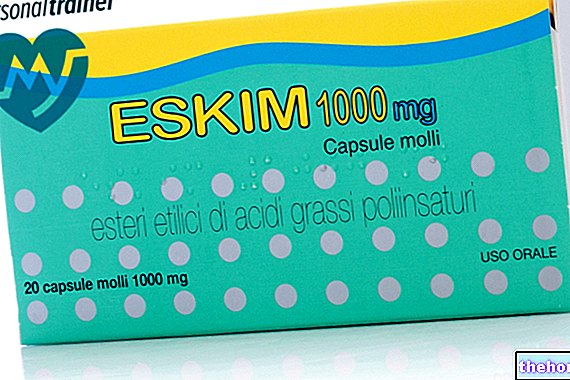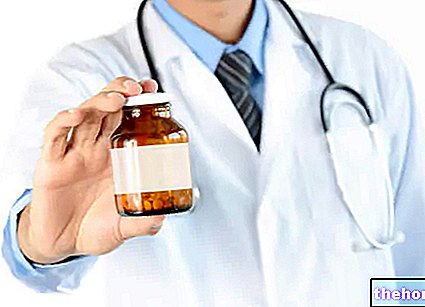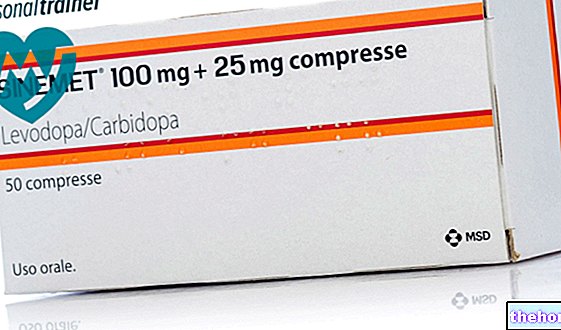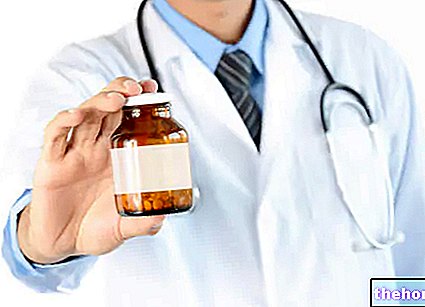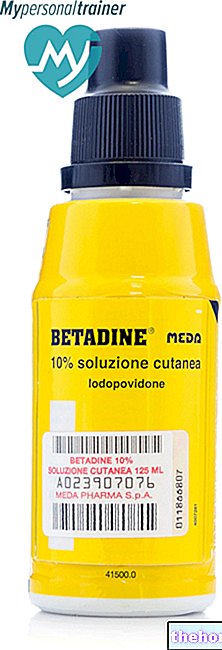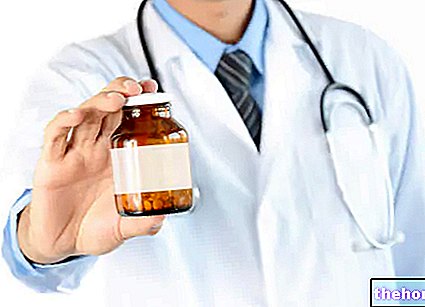Active ingredients: Ethylephrine (ethylephrine hydrochloride)
EFFORTIL 7.5 mg / ml oral drops, solution
EFFORTIL 5 mg tablets
Effortil package inserts are available for pack sizes: - EFFORTIL 7.5 mg / ml oral drops, solution, EFFORTIL 5 mg tablets
- EFFORTIL 10 mg / 1 ml solution for injection
Why is Effortil used? What is it for?
PHARMACOTHERAPEUTIC CATEGORY
Cardiac sympathomimetic (adrenergic) for cardiovascular therapy used in the treatment of hypotension.
THERAPEUTIC INDICATIONS
Treatment of orthostatic hypotension.
Contraindications When Effortil should not be used
Effortil is contraindicated in:
- patients hypersensitive to the active substance or to any of the excipients
- patients with hypotensive deregulation that produces a hypertensive reaction when standing
- first trimester of pregnancy and during lactation (see section "Special warnings").
The use of the medicinal product is contraindicated in case of rare hereditary conditions, which may be incompatible with one of the excipients (see section "Special warnings").
Like other sympathomimetics, Effortil is contraindicated in patients with:
- hypertension
- thyrotoxicosis
- pheochromocytoma
- closed-angle glaucoma
- prostatic hypertrophy or prostate adenoma with urinary retention
- coronary insufficiency
- decompensated heart failure
- hypertrophic obstructive cardiomyopathy
- stenosis of the heart valves or central arteries
- heart rhythm disturbances.
Precautions for use What you need to know before taking Effortil
Administer with caution in patients with tachycardia, cardiac arrhythmias, severe cardiovascular disorders.
Administer with caution in patients with diabetes mellitus (see section "Interactions").
Administer with caution in patients with hyperthyroidism.
Furthermore, do not administer during or in the two weeks following MAOI therapy (see section "Interactions").
Interactions Which drugs or foods can modify the effect of Effortil
Tell your doctor or pharmacist if you have recently taken any other medicines, even those without a prescription. The effects of Effortil may be enhanced by concomitant administration of guanethidine, mineralocorticoids, reserpine, thyroid hormones, other sympathomimetics or any other substance with sympathomimetic activity (such as tricyclic antidepressants, MAO inhibitors and antihistamines). Do not administer during or in the two weeks following MAOI therapy.
Halogenated aliphatic hydrocarbons present in inhalation anesthetics and cardiac glycosides in high doses can increase the effects of sympathomimetic agents on the heart and thus can lead to cardiac arrhythmias.
Dihydroergotamine increases the enteral absorption of Effortil and, consequently, increases its action.
Atropine can lead to a greater effect of Effortil and an increase in heart rate.
Adrenergic blocking agents (alpha-blockers and beta-blockers) can partially or completely cancel the effect of ethylephrine. Treatment with beta-blockers can induce reflex bradycardia.
The hypoglycemic action of antidiabetic drugs can be reduced.
The effect of ethylephrine is enhanced by the simultaneous intake of deoxycorticosterone acetate (DOCA). Quinidine reduces its pharmacological activity.
Warnings It is important to know that:
Tablets
The tablets contain lactose, if you have been told by your doctor that you have an "intolerance to some sugars, contact your doctor before taking this medicine.
The tablets contain sodium metabisulphite: this substance can rarely cause severe hypersensitivity reactions and bronchospasm.
Oral drops
The oral drops contain methyl-para-hydroxybenzoate and propyl-para-hydroxybenzoate which cause allergic reactions (even delayed).
Effortil oral drops should be used with caution in children under two years of age, due to their limited ability to metabolise the excipient propyl-para-hydroxybenzoate (propyl parabens). Available data on possible effects, for example on the male reproductive system , are insufficient and there are currently no recommendations for maximum daily exposure for this age group. The use of a formulation containing propylparabens in children under two years of age should be justified on a case-by-case basis, considering the need for treatment versus the potential risk. Talk to your doctor in case of use in children under two years of age.
The oral drops contain sodium metabisulfite: this substance can rarely cause severe hypersensitivity reactions and bronchospasm.
Fertility, pregnancy and breastfeeding
Ask your doctor or pharmacist for advice before taking any medicine
Pregnancy
Effortil is contraindicated in the first trimester of pregnancy as clinical data are insufficient and non-clinical data have demonstrated a teratogenic effect (see section "Contraindications"). In the second and third trimester of pregnancy, Effortil should only be administered after a careful risk / benefit assessment. Effortil can cause decreased degree of uteroplacental perfusion and can cause uterine relaxation.
Feeding time
The passage of Effortil into milk cannot be excluded, therefore Effortil is contraindicated during lactation (see section "Contraindications").
Fertility
Preclinical fertility studies with ethylephrine have not been conducted. Studies on the effect of ethylephrine on human fertility have not been conducted.
Effects on ability to drive and use machines
No studies on the ability to drive and use machines have been performed. However, patients should be warned of the possible onset of undesirable effects such as dizziness during treatment with Effortil. Therefore, caution should be advised when driving vehicles or using machines.
For those who carry out sporting activities: the use of the drug without therapeutic necessity constitutes doping and can in any case determine positive anti-doping tests.
Dosage and method of use How to use Effortil: Dosage
Oral drops, solution
The recommended dose is 5-10 oral drops, 3 times a day. See paragraph "Special warnings".
Instructions for Use
The bottle is equipped with a child-resistant safety closure, to open follow the instructions below:
Tablets
The recommended dose is 1/2 to 1 tablet, 3 times a day.
Overdose What to do if you have taken too much Effortil
In case of accidental ingestion / intake of an excessive dose of Effortil, notify your doctor immediately or go to the nearest hospital.
Symptoms
An acute overdose accentuates the side effects described below. In addition, agitation and vomiting may occur. In infants and infants, overdose can cause central respiratory depression and coma.
Treatment
Appropriate symptomatic treatment should be undertaken. In case of severe intoxication, adequate resuscitation and supportive measures should be undertaken. Symptoms due to beta1-sympathomimetic action can be treated with beta-blockers administered in accordance with the usual prescribing methods typical of this class of drugs.
If you have any further questions on the use of Effortil, ask your doctor or pharmacist.
Side Effects What are the side effects of Effortil
Like all medicines, Effortil can cause side effects, although not everybody gets them.
Adverse reactions are listed below by system organ class and frequency, according to the following categories:
Very common ≥ 1/10
Common ≥ 1/100
Uncommon ≥ 1 / 1,000
Rare ≥ 1 / 10,000
Very rare
Not known frequency cannot be estimated from the available data.
Immune system disorders:
Not known: Hypersensitivity (allergic reactions).
Psychiatric disorders:
Uncommon: Anxiety, insomnia.
Nervous system disorders:
Common: Headache.
Uncommon: Tremor, restlessness, dizziness.
Ear and labyrinth disorders:
Uncommon: Vertigo.
Cardiac disorders:
Uncommon: Arrhythmia, tachycardia, palpitations.
Not known: Angina pectoris, increased blood pressure.
Gastrointestinal disorders:
Uncommon: Nausea.
General disorders and administration site conditions:
Not known: Hyperhidrosis.
Other reported side effects: vomiting and reflex bradycardia.
Reporting of side effects
If you get any side effects, talk to your doctor or pharmacist. This includes any possible side effects not listed in this leaflet. Undesirable effects can also be reported directly through the national reporting system at "https://www.aifa.gov.it/content/segnalazioni-reazioni-avverse". By reporting side effects you can help provide more information on the safety of this medicine.
Expiry and Retention
Expiry: see the expiry date printed on the package.
The expiry date refers to the product in intact packaging, correctly stored.
Warning: do not use the medicine after the expiry date shown on the package.
Medicines should not be disposed of via wastewater or household waste. Ask your pharmacist how to throw away medicines you no longer use. This will help protect the environment.
Keep this medicine out of the reach and sight of children.
Composition and pharmaceutical form
COMPOSITION
EFFORTIL 7.5 mg / ml oral drops, solution
100 g contain: Active ingredient: ethylephrine hydrochloride 0.75 g. (1 g, about 15 drops (1 ml), contains: Active ingredient: 7.5 mg ethylephrine hydrochloride).
Excipients: methyl-para-hydroxybenzoate, propyl-para-hydroxybenzoate, sodium metabisulphite, purified water.
EFFORTIL 5 mg tablets
One tablet contains: Active ingredient: 5 mg etylephrine hydrochloride.
Excipients: lactose, corn starch, anhydrous colloidal silica, soluble starch, sodium metabisulphite, mixture of glycerides.
PHARMACEUTICAL FORM AND CONTENT
EFFORTIL 7.5 mg / ml oral drops, solution - Bottle of 15 g
EFFORTIL 5 mg tablets - Box containing 2 blisters of 10 tablets
Source Package Leaflet: AIFA (Italian Medicines Agency). Content published in January 2016. The information present may not be up-to-date.
To have access to the most up-to-date version, it is advisable to access the AIFA (Italian Medicines Agency) website. Disclaimer and useful information.
01.0 NAME OF THE MEDICINAL PRODUCT
EFFORTIL
02.0 QUALITATIVE AND QUANTITATIVE COMPOSITION
Oral drops, solution
100 g contain: ethylephrine hydrochloride 0.75 g
(1 g, about 15 drops (1 ml), contains: 7.5 mg ethylephrine hydrochloride).
Excipients with known effects: Methyl-para-hydroxybenzoate, propyl-para-hydroxybenzoate, sodium metabisulphite.
For the full list of excipients, see section 6.1.
Tablets
One tablet contains: 5 mg etylephrine hydrochloride.
Excipients with known effects: Lactose, sodium metabisulphite.
For the full list of excipients, see section 6.1.
03.0 PHARMACEUTICAL FORM
Oral drops, solution.
Tablets.
04.0 CLINICAL INFORMATION
04.1 Therapeutic indications
Treatment of orthostatic hypotension.
04.2 Posology and method of administration
Oral drops, solution
The recommended dose is 5-10 drops, 3 times a day. See section 4.4.
Tablets
The recommended dose is 1/2 to 1 tablet, 3 times a day.
04.3 Contraindications
Effortil is contraindicated in:
• patients hypersensitive to ethylephrine or to any of the excipients
• patients with hypotensive deregulation producing a hypertensive reaction when standing
• first trimester of pregnancy and during lactation (see section 4.6)
The use of the medicinal product is contraindicated in case of rare hereditary conditions, which may be incompatible with any of the excipients (see section 4.4).
Like other sympathomimetics, Effortil is contraindicated in patients with:
• hypertension
• thyrotoxicosis
• pheochromocytoma
• angle-closure glaucoma
• prostatic hypertrophy or prostate adenoma with urinary retention
• coronary insufficiency
• decompensated heart failure
• hypertrophic obstructive cardiomyopathy
• stenosis of the heart valves or central arteries
• heart rhythm disturbances
04.4 Special warnings and appropriate precautions for use
Administer with caution in patients with tachycardia, cardiac arrhythmias, severe cardiovascular disorders.
Administer with caution in patients with diabetes mellitus (see section 4.5).
Administer with caution in patients with hyperthyroidism.
Also do not administer during or for two weeks following MAOI therapy (see section 4.5).
The use of ethylephrine during an athletic competition determines positivity to the tests for the use of substances without therapeutic need, for example those used to improve sports performance.
Tablets
One tablet contains 31.8 mg of lactose, corresponding to 190.8 mg of lactose in the maximum recommended daily dose (adults).
Patients with rare hereditary problems of galactose intolerance, such as galactosemia, lactase deficiency, or glucose-galactose malabsorption, should not take this medicine.
The tablets contain sodium metabisulphite: this substance can rarely cause severe hypersensitivity reactions and bronchospasm.
Oral drops
The oral drops contain methyl-para-hydroxybenzoate and propyl-para-hydroxybenzoate which cause allergic reactions (even delayed).
Effortil oral drops should be used with caution in children under two years of age, due to their limited ability to metabolise the excipient propyl-para-hydroxybenzoate (propyl parabens). Available data on possible effects, for example on the male reproductive system , are insufficient and there are currently no recommendations for maximum daily exposure for this age group. The use of a formulation containing propylparabens in children under two years of age must be justified on a case-by-case basis, considering the need for treatment versus the potential risk.
The risk / benefit assessment should take into account several factors including posology, probylparaben concentration, duration of treatment, disease severity and the availability of alternative treatments.
Patients / carers should seek medical attention.
The oral drops contain sodium metabisulfite: this substance can rarely cause severe hypersensitivity reactions and bronchospasm.
The bottle has a child resistant safety closure.
04.5 Interactions with other medicinal products and other forms of interaction
The effects of Effortil may be enhanced by concomitant administration of guanethidine, mineralocorticoids, reserpine, thyroid hormones, other sympathomimetics or any other substance with sympathomimetic activity (such as tricyclic antidepressants, antihistamines and MAO inhibitors). Do not administer during or in the two weeks following MAOI therapy.
Halogenated aliphatic hydrocarbons present in inhalation anesthetics and cardiac glycosides in high doses can increase the effects of sympathomimetic agents on the heart and thus can lead to cardiac arrhythmias.
Dihydroergotamine increases the enteral absorption of Effortil and, consequently, increases its action.
Atropine can lead to a greater effect of Effortil and an increase in heart rate.
Adrenergic blocking agents (alpha-blockers and beta-blockers) can partially or completely cancel the effect of ethylephrine. Treatment with beta-blockers can induce reflex bradycardia.
The hypoglycemic action of antidiabetic drugs can be reduced.
The effect of ethylephrine is enhanced by the simultaneous intake of deoxycorticosterone acetate (DOCA). Quinidine reduces its pharmacological activity.
04.6 Pregnancy and lactation
Pregnancy
Effortil is contraindicated in the first trimester of pregnancy as clinical data are insufficient and non-clinical data have demonstrated a teratogenic effect (see sections 4.3 and 5.3).
In the second and third trimester of pregnancy Effortil should only be administered after a "careful risk / benefit assessment.
Ethylephrine can cause decreased degree of uteroplacental perfusion and can cause uterine relaxation.
Feeding time
Passage of Effortil into milk cannot be excluded, therefore Effortil is contraindicated during lactation (see section 4.3).
Fertility
Preclinical fertility studies with ethylephrine have not been conducted.
Studies on the effect of ethylephrine on human fertility have not been conducted.
04.7 Effects on ability to drive and use machines
No studies on the ability to drive and use machines have been performed. However, patients should be warned of the possible onset of undesirable effects such as dizziness during treatment with Effortil. Therefore, caution should be advised when driving vehicles or using machines.
04.8 Undesirable effects
Adverse reactions are listed below by system organ class and frequency, according to the following categories:
Very common ≥ 1/10
Common ≥ 1/100
Uncommon ≥ 1 / 1,000
Rare ≥ 1 / 10,000
Very rare
Not known frequency cannot be estimated from the available data.
Disorders of the immune system:
Not known: hypersensitivity (allergic reactions).
Psychiatric disorders:
Uncommon: anxiety, insomnia.
Nervous system disorders:
Common: headache.
Uncommon: tremor, restlessness, dizziness.
Ear and labyrinth disorders:
Uncommon: dizziness.
Cardiac pathologies:
Uncommon: arrhythmia, tachycardia, palpitations.
Not known: angina pectoris, increased blood pressure.
Gastrointestinal disorders:
Uncommon: nausea
General disorders and administration site conditions:
Not known: hyperhidrosis
Other reported side effects: vomiting, reflex bradycardia.
Reporting of suspected adverse reactions
Reporting of suspected adverse reactions occurring after authorization of the medicinal product is important as it allows continuous monitoring of the benefit / risk balance of the medicinal product. Healthcare professionals are asked to report any suspected adverse reactions via the national reporting system. "address https://www.aifa.gov.it/content/segnalazioni-reazioni-avverse.
04.9 Overdose
Symptoms: acute overdose accentuates the side effects described above. In addition, agitation and vomiting may occur. In infants and infants, overdose can cause central respiratory depression and coma.
Treatment: Appropriate symptomatic treatment should be undertaken.
In case of severe intoxication, adequate resuscitation and supportive measures should be undertaken.
Symptoms due to beta1-sympathomimetic action can be treated with beta-blockers administered according to the usual prescribing methods typical of this class of drugs.
05.0 PHARMACOLOGICAL PROPERTIES
05.1 Pharmacodynamic properties
Pharmacotherapeutic group: cardiac, adrenergic and dopaminergic stimulants.
ATC code: C01CA01.
Ethilephrine, the active ingredient in Effortil, is a direct sympathomimetic agent with a "high affinity for alpha1 and beta1 receptors. At higher doses, beta2 receptors may also be activated. Therefore, ethilephrine is capable of increasing cardiac contractility and increasing cardiac contractility. cardiac output by increasing the systolic volume; in addition, it increases venous tone and central venous pressure and leads to an increase in the volume of circulating blood.
The positive inotropic effect has been seen in patients with normal cardiac performance or with mild insufficiency.
The drug increases systolic blood pressure to a greater extent than diastolic blood pressure.
05.2 "Pharmacokinetic properties
Absorption
As a result of the hepatic first pass effect, the bioavailability of the oral solution is approximately 8% while that of the tablets is approximately 12%.
Distribution
Approximately 23% of the drug is bound to plasma proteins. Following a single oral dose of 10 mg (tablets and oral solution), the maximum (median) plasma concentration is achieved after approximately 20 minutes for the tablets (8 ng / ml) and after approximately 30 minutes for the oral solution (5 ng / ml).
The medicinal product was not found to cross the blood-brain barrier when administered in a labeled form to rats. It is not yet known whether ethylephrine crosses the placental barrier or is excreted in breast milk.
Biotransformation
Ethylephrine is primarily eliminated by metabolism. The major human metabolite is the conjugated form with sulfuric acid. There is no evidence that the metabolites are active.
Elimination
The terminal elimination half-life is approximately 2 hours. Following administration of the tritium-labeled medicinal product, 75-80% of the total radioactivity is recovered in the urine.
Since ethylephrine and its conjugation derivatives are mainly excreted via the kidney, conjugation products may accumulate in patients with renal insufficiency.
05.3 Preclinical safety data
In acute toxicity studies with oral single dose ethylephrine in mice, rats, rabbits and dogs, the LD50 ranged from 66.4 mg / kg (rat) to 2300 mg / kg (mouse). Following intravenous administration in mice, rabbits and dogs, the corresponding values were between 6.8 and 16.7 mg / kg. The main signs of toxicity were piloerection, exophthalmos, cyanosis, tachypnea, salivation, ataxia, convulsions (in rodents) and in addition, mydriasis, tremor and vomiting (in dogs). Following subcutaneous administration in rodents, the LD50 was in the range of 200-300 mg / kg.
In repeat-dose studies with oral ethylephrine - up to 26 weeks - the maximum dose at which no observed adverse effects were observed (NOAEL) was 3 mg / kg in rats and 0.6 mg / kg in dogs. At doses of 3 and 6 mg / kg in rats and dogs, a decrease in heart rate, blood glucose (in the rat) or an increase in blood pressure and intraocular pressure, mydriasis and an increase in blood glucose, respectively, were observed. hepatic enzyme SGPT (ALT) (in dogs). In both species, fibrosis of the myocardium and mitral valve was observed at doses of 6-30 mg / kg. In addition, increased heart weight was observed in dogs. , and a hyperplasia of the media of the small arteries.
In an i.v. toxicity study in dogs of 4 weeks duration the NOAEL value was 0.625 mg / kg. At 3.1 mg / kg appeared: emesis, decreased rate of growth of body weight, increased serum alkaline phosphatase. Ethylephrine did not show any genotoxic potential (in vitro) in bacterial and mammalian cells. No carcinogenicity studies are available.
Oral doses up to 15 mg / kg of ethylephrine in mice, rats and rabbits are non-embryolethal and teratogenic.
At maternotoxic doses (greater than 30 mg / kg orally) fetal delays were observed in rats and a higher incidence of malformations in mice. These congenital defects are associated with an exaggerated pharmacodynamic effect on the uterine vessels following overdose. Administration of ethylephrine to pregnant guinea pigs lowers uterine blood flow.
In rabbits, ethylephrine was tolerated following cutaneous application and induced moderate irritation after intramuscular administration.
06.0 PHARMACEUTICAL INFORMATION
06.1 Excipients
EFFORTIL 7.5 mg / ml oral drops, solution: methyl-para-hydroxybenzoate, propyl-para-hydroxybenzoate, sodium metabisulphite, purified water.
EFFORTIL 5 mg tablets: lactose, corn starch, anhydrous colloidal silica, soluble starch, sodium metabisulphite, mixture of glycerides.
06.2 Incompatibility
Incompatibilities with other medicines are unknown.
06.3 Period of validity
EFFORTIL 7.5 mg / ml oral drops, solution: 3 years.
EFFORTIL 5 mg tablets: 5 years.
06.4 Special precautions for storage
This medicinal product does not require any special storage conditions.
06.5 Nature of the immediate packaging and contents of the package
EFFORTIL 7.5 mg / ml oral drops, solution:
15 g dark glass bottle, hydrolytic class III, with dropper. Bottle with child resistant safety closure.
EFFORTIL 5 mg tablets:
Carton containing 2 opaque AL / PVC blisters of 10 tablets.
06.6 Instructions for use and handling
No special instructions
07.0 MARKETING AUTHORIZATION HOLDER
Boehringer Ingelheim Italia S.p.A.
Via Lorenzini, 8
20139 Milan
08.0 MARKETING AUTHORIZATION NUMBER
EFFORTIL 7.5 mg / ml oral drops, solution - 1 bottle of 15g: AIC 006774032
EFFORTIL 5 mg tablets - 20 tablets: AIC 006774044
09.0 DATE OF FIRST AUTHORIZATION OR RENEWAL OF THE AUTHORIZATION
EFFORTIL 7.5 mg / ml oral drops, solution: 29.09.1955 / 01.06.2010
EFFORTIL 5 mg tablets: 30.07.1952 / 01.06.2010
10.0 DATE OF REVISION OF THE TEXT
10 February 2015

